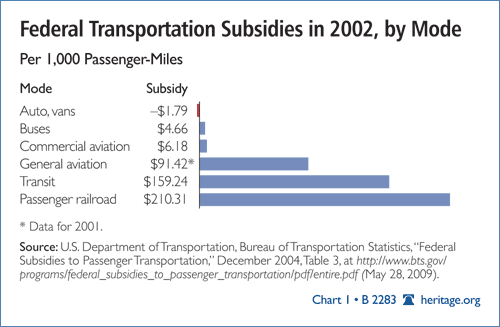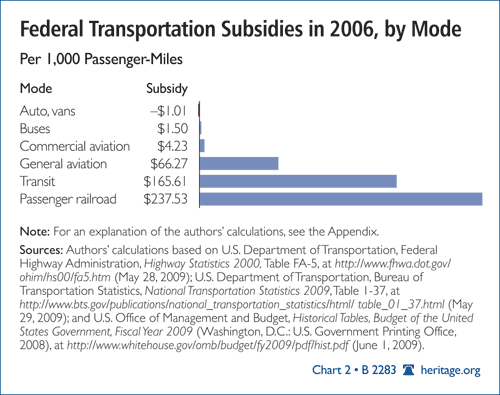In December 2004, the Bureau of Transportation Statistics at the U.S. Department of Transportation (USDOT) published its first and last report on the cost of the federal subsidies provided to each mode of transportation per passenger per 1,000 miles: cars, buses, airplanes, transit, and passenger railroad. The survey covered the years 1990 to 2002 and demonstrated that motorists received the lowest federal subsidy per 1,000 passenger-miles and that transit and Amtrak received by far the largest federal subsidies.[1]
Indeed, the study found that the federal transportation program actually made a "profit" from motorists because they paid more in user fees and taxes (mostly the 18.3 cent per gallon federal fuel tax/user fee) than they received in subsidies for roads. Approximately 20 percent of fees and taxes paid into the highway trust fund by motorists was diverted to the Transit Account within the Highway Trust Fund to subsidize transit.[2]
According to the USDOT report, the federal subsidies per mode, per passenger, per 1,000 miles for 2002 (the final year of the survey) were as shown in Chart 1.

The federal policy implications of these findings were profound. They revealed that, from the perspective of the federal budget, transit and passenger rail were exceptionally expensive ways to move people from point A to point B and that a road-focused transportation policy would deliver a bigger bang for federal money invested, as measured by passengers served.
Not surprisingly, the much higher subsidies revealed by the report were an embarrassment to transit and train advocates in Congress, and USDOT was discouraged from further exercises in transparency. Consequently, the 2004 report was the first and last of its kind.
In this paper, The Heritage Foundation has updated and replicated the original 2004 USDOT study by adding new data for 2003 through 2006.
Measuring Federal Transportation subsidies
Recently, Secretary of Transportation Ray LaHood announced that his department would partner with the Department of Housing and Urban Development to develop a housing and transportation cost index to "redefine affordability and make it transparent," thereby better illuminating the true costs.[3] Because a large portion of surface transportation costs is borne by the federal and the state governments and funded through a combination of general tax revenues and user fees and taxes, it is essential that an accurate and transparent transportation cost index incorporate these various subsidies into any analysis of the housing and transportation trade-offs under review.
To facilitate this goal and to assist Secretary LaHood in his pursuit of greater transparency, this paper provides a detailed update of the data collected and presented in the 2004 report. This updated subsidy information is important for developing an effective transportation policy that yields the greatest mobility for the least cost and better reveals the true housing and transportation trade-offs.
With this in mind, The Heritage Foundation has updated and replicated the original 2004 USDOT study by adding new data for 2003 through 2006. The update found that the relationships between the modes and the magnitude of their relative subsidies per 1,000 passenger-miles have not changed significantly since the 2004 study. Based on the Heritage Foundation update, Chart 2 shows the 2006 federal subsidies per mode, per 1,000 passenger-miles. (For the annual data from 1990 through 2006 and details on the data and calculations, see the Appendix.)

As the updated data reveal, transit and passenger rail still require the largest federal subsidies per 1,000 passenger-miles to operate, while motorists still provide the federal government with a "profit" because they pay more in user fees and taxes than they receive in federal spending.
The key to determining the magnitude of the federal subsidy that the passengers of each mode receive from the federal government is to separate the funding that each mode receives from its users (in the form of user fees) from the funding that it receives from the general taxpayer and from fees paid by users of other modes. For example, the federal highway trust fund relies entirely on fuel tax revenues and excise taxes paid by motorists and truckers. In 2007, these users provided $39.3 billion to the trust fund, yet they received only about 60 percent of those revenues back in the form of federal spending on general-purpose roads.[4] The remaining 40 percent was diverted to programs such as transit, National Parks, Appalachian development, hiking trails, bicycle paths, historic renovation, ferries, administrative costs, subsidies to metropolitan planning organizations, universities, and various programs for community development.
Likewise, the federal subsidy per 1,000 passenger-miles for intercity buses is relatively low because these buses pay a federal fuel tax related to usage. The same holds true for commercial aviation in which both passengers and the airlines pay up to 17 separate fees, taxes, and charges for an international flight and 10 separate taxes, fees, and charges for a domestic flight. As in the cases of motorists and intercity bus operators, commercial airline passengers are largely "subsidizing" themselves.
In contrast to motorists and commercial airlines, transit users pay no federal taxes or fees and instead benefit by receiving a share of the taxes paid by motorists and funding from general federal tax revenues. In addition, transit's per-passenger subsidy costs are also much higher because fewer than 2 percent of passengers use transit, yet transit receives more than 20 percent of federal subsidies. Similarly, passengers served by rail (Amtrak) pay no federal tax or user fee and benefit from a very substantial subsidy provided by the general taxpayers.
Implications
In addition to the many policy-related benefits to Secretary LaHood and the USDOT, the updated data and analysis can also help Representative James Oberstar (D-MN), chairman of the House Committee on Transportation and Infrastructure, with his new performance-based approach. The chairman's recent outline on prospective changes in the federal highway and transit program urged "a shift from prescriptive to performance" and proposes four performance categories.[5]
Given that worsening congestion is among the most pressing problems confronting surface transportation policymakers, alleviating congestion will certainly be among Chairman Oberstar's top transportation performance measures.[6] The subsidy data provided in this paper, like those of the previous federal report, reveal that the federal cost of supporting rail and transit passengers is excessively high and that investing in roads would be a more cost-effective solution that would accommodate the needs of most commuters and travelers.
Wendell Cox, Principal of the Wendell Cox Consultancy in St. Louis, Missouri, is a Visiting Fellow, and Ronald D. Utt, Ph.D., is Herbert and Joyce Morgan Senior Research Fellow in the Thomas A. Roe Institute for Economic Policy Studies, at The Heritage Foundation.
Appendix
Data Sources and Calculations
Except for the revisions noted below, the updated estimates of federal subsidies included in this paper use the same data and the same methodology as used in the USDOT publication "Federal subsidies to Passenger Transportation."[7]
Sources of Financial Data
|
Highways
|
1990-2002
|
"Federal subsidies to Passenger Transportation"
|
|
2003-2006
|
Expenditures were allocated to autos, pickups, and vans, using the 2000 FHWA cost-allocation methodology in Table FA-5 of Highway Statistics 2000.[8] This included highways in national parks and national forests and all other expenditures. Revenues were taken from U.S. Office of Management and Budget, "Federal Receipts from 1976."[9] subsidies were allocated among school, transit, and intercity buses using the shares for 2002 in "Federal subsidies to Passenger Transportation."The shares were based on vehicle registration.
|
|
|
Air
|
1990-2002
|
"Federal subsidies to Passenger Transportation"
|
|
2003-2006
|
subsidies were allocated to commercial and general aviation, using the shares for 2002 in "Federal subsidies to Passenger Transportation."
|
|
|
Transit
|
1990-2002
|
"Federal subsidies to Passenger Transportation"
|
|
2003-2006
|
Federal outlays from 1962[10]
|
|
|
Amtrak
|
1990-2002
|
"Federal subsidies to Passenger Transportation"
|
|
2003-2006
|
Federal outlays from 1962
|
Passenger-Miles
Except for general aviation, all passenger-mile figures were taken from National Transportation Statistics, Table 1-37.[11] The most recent reported general aviation data are for 2001. Subsequent data were estimated using ratio of flight hours compared to 2001.
Revisions in This Paper
Autos, Pickups, and Vans. In some years, "Federal subsidies to Passenger Transportation" used vehicle miles, not passenger-miles, in calculating the passenger-miles metric. This overstated any net subsidy (positive or negative). We have substituted the passenger-miles data as reported in National Transportation Statistics, Table 1-37.[12]
Buses. In calculating the subsidies for buses, "Federal subsidies to Passenger Transportation"used only intercity bus passenger-miles. Thus, the entire subsidy for school buses, transit buses (the subsidy from use of the roads, which is not included in transit financial data) and intercity buses was charged to intercity buses alone. We have revised the subsidy data based on the total bus passenger-miles (from all three bus types) from NTS Table 1-37.[13]

